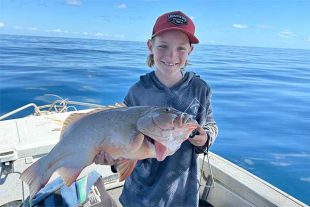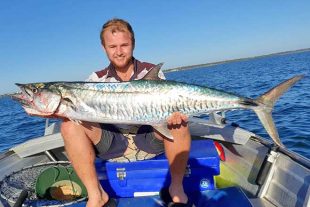With the winds continuing to hamper the offshore crew things have been all about fishing the beach, estuaries and the freshwater. A few of the larger offshore boats have managed to get out to North Reef and have come home with solid snapper, tuskies, pearlies and other reefies including cobia.
In the rivers the salt content has been driven so high from the lack of rains we have even seen mac tuna entering the maroochy river system and chasing baitfish! This goes to show you that you never know what is about.
In the local Noosa River this week’s tides brought bigger spring tides with the new moon phase. As such the trevally have been coming in and a solid 80cm diamond trevally was caught in woods bay. This is fast becoming a great place to find such monster fish.
For the rest of you then early mornings can be great here, especially on an incoming tide. The surface lure fishing bite is getting stronger in the smooth water and trevally often smash bait up in these bays so keep a watchful eye on the birds as they will soon tell you where the fish are.
Also around the lower part of the river flathead continue to feature strongly and are taking a huge range of lures and baits. Bait anglers would do well to fish whole fish baits like hardy heads and pilchards and let them drift around on a light gauge Citer gang hook in the current. The river mouth has some great drop offs so fish the turn in the tides here. Also on the catch list here are whiting and bream. Around the rocks and sandbags of the dog beach you may find mangrove jacks which are starting to become more active. These fish love and dead baits, especially fresh mullet chunks. Be sure to use 4/0-6/0 octopus style hooks here as they hit hard and pull a lot of drag. Soft vibes are great for all areas of the lower estuary and the Zerek fish traps are very popular especially if new to using lures. Grab your cast net and get some lives for your live bait bucket as Jacks will hammer a well-placed live bait too.
Away from flathead and bream we have jewfish which will become increasingly more active as we approach the new moon. These fish love to sit in deep holes and out of the main currents, but will come out in the open during a slack tide. Fresh baits of mullet, pilchard and live worms work well for them and are best fished in low light or after dark hours. Be sure to up leaders to 20-40lb depending on where you fish as they do hang around rocks and heavy structure. Take a look around the river mouth rocks, munna bridge and of course the Noosa National Park headlands if the swell and winds allow.
Off the beaches we have seen consistent catches of small whiting, dart and bream. There are a few tailor hanging around the various gutters along the coast but these are smaller sized and showing up mainly during the evening times. This time is also a great time to fish for jewfish as the new moon period is thought to be one of the best times, especially if there are tailor running too. Be sure to keep baits fresh and well presented on lighter lines as jewies can be very wary of heavy lines. Snelled rigs work especially well if using slab baits or live baits so ask us how to rig one if you need help.
The freshwaters of lake Macdonald and Borumba are producing chunky bass and even saratoga to 70cm. The consistent sunshine and lack of rains continue to warm things up. If wanting to target these fish during windier days be sure to have an assortment of suspending jerk baits in the 60-80mm body size. As for colours then Ayu and black and gold are two personal favourites. For both species try and use the wind to your advantage to make wind assisted casts. This keeps you away from the edges and possibly spooking bigger fish. Although warmer the waters are still cool so be sure to put in long pauses as this is when the big bites will come. In the cooler waters the fish may be a little more lethargic so patience is key. Consistent performing lures include Lucky Craft pointers, Jackall squirrels, Norries laydown minnows and Zerek Tango Shads to name a few. Lastly don’t forget to purchase your SIPS permit before taking to one of our local stocked impoundments so that more and more fingerlings can be released each year.
 Bush ‘n Beach Fishing Magazine Location reports & tips for fishing, boating, camping, kayaking, 4WDing in Queensland and Northern NSW
Bush ‘n Beach Fishing Magazine Location reports & tips for fishing, boating, camping, kayaking, 4WDing in Queensland and Northern NSW









